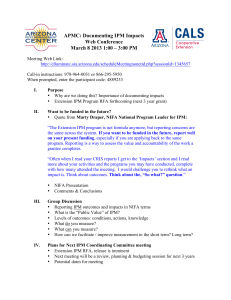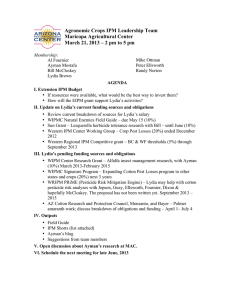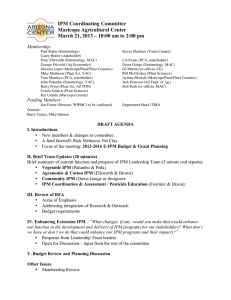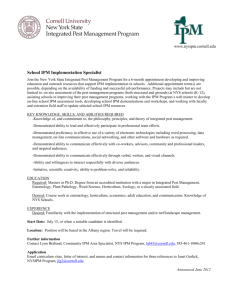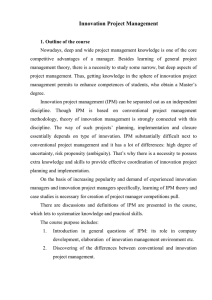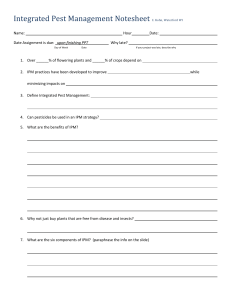IPM Coordinating Committee Maricopa Agricultural Center
advertisement
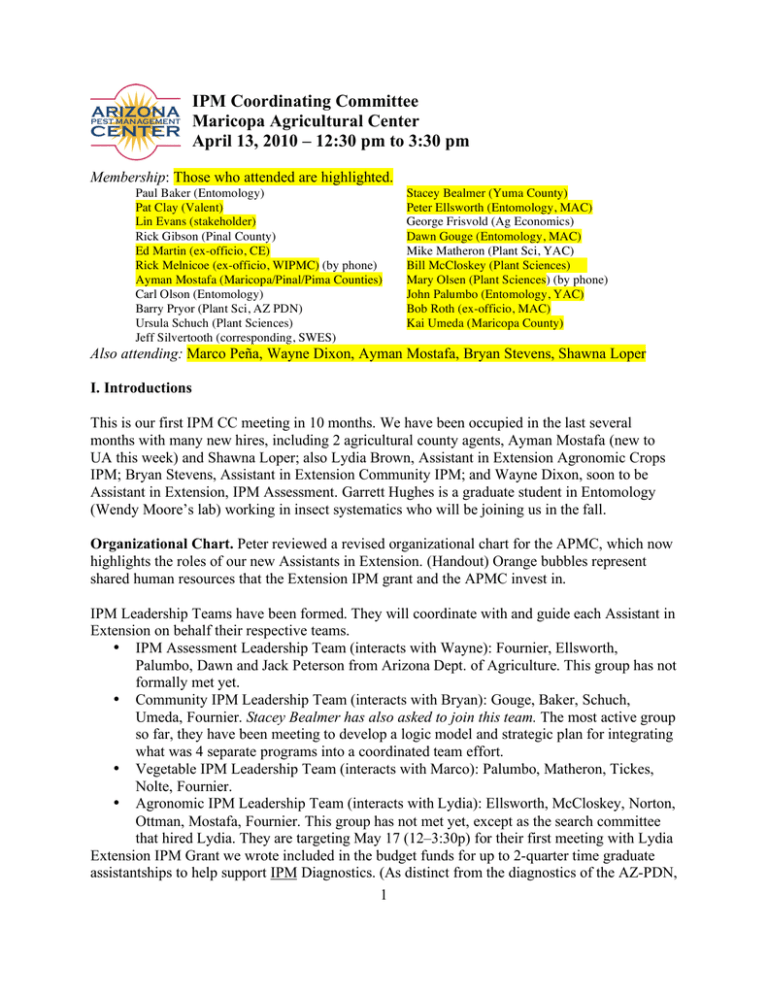
IPM Coordinating Committee Maricopa Agricultural Center April 13, 2010 – 12:30 pm to 3:30 pm Membership: Those who attended are highlighted. Paul Baker (Entomology) Pat Clay (Valent) Lin Evans (stakeholder) Rick Gibson (Pinal County) Ed Martin (ex-officio, CE) Rick Melnicoe (ex-officio, WIPMC) (by phone) Ayman Mostafa (Maricopa/Pinal/Pima Counties) Carl Olson (Entomology) Barry Pryor (Plant Sci, AZ PDN) Ursula Schuch (Plant Sciences) Jeff Silvertooth (corresponding, SWES) Stacey Bealmer (Yuma County) Peter Ellsworth (Entomology, MAC) George Frisvold (Ag Economics) Dawn Gouge (Entomology, MAC) Mike Matheron (Plant Sci, YAC) Bill McCloskey (Plant Sciences) Mary Olsen (Plant Sciences) (by phone) John Palumbo (Entomology, YAC) Bob Roth (ex-officio, MAC) Kai Umeda (Maricopa County) Also attending: Marco Peña, Wayne Dixon, Ayman Mostafa, Bryan Stevens, Shawna Loper I. Introductions This is our first IPM CC meeting in 10 months. We have been occupied in the last several months with many new hires, including 2 agricultural county agents, Ayman Mostafa (new to UA this week) and Shawna Loper; also Lydia Brown, Assistant in Extension Agronomic Crops IPM; Bryan Stevens, Assistant in Extension Community IPM; and Wayne Dixon, soon to be Assistant in Extension, IPM Assessment. Garrett Hughes is a graduate student in Entomology (Wendy Moore’s lab) working in insect systematics who will be joining us in the fall. Organizational Chart. Peter reviewed a revised organizational chart for the APMC, which now highlights the roles of our new Assistants in Extension. (Handout) Orange bubbles represent shared human resources that the Extension IPM grant and the APMC invest in. IPM Leadership Teams have been formed. They will coordinate with and guide each Assistant in Extension on behalf their respective teams. • IPM Assessment Leadership Team (interacts with Wayne): Fournier, Ellsworth, Palumbo, Dawn and Jack Peterson from Arizona Dept. of Agriculture. This group has not formally met yet. • Community IPM Leadership Team (interacts with Bryan): Gouge, Baker, Schuch, Umeda, Fournier. Stacey Bealmer has also asked to join this team. The most active group so far, they have been meeting to develop a logic model and strategic plan for integrating what was 4 separate programs into a coordinated team effort. • Vegetable IPM Leadership Team (interacts with Marco): Palumbo, Matheron, Tickes, Nolte, Fournier. • Agronomic IPM Leadership Team (interacts with Lydia): Ellsworth, McCloskey, Norton, Ottman, Mostafa, Fournier. This group has not met yet, except as the search committee that hired Lydia. They are targeting May 17 (12–3:30p) for their first meeting with Lydia Extension IPM Grant we wrote included in the budget funds for up to 2-quarter time graduate assistantships to help support IPM Diagnostics. (As distinct from the diagnostics of the AZ-PDN, 1 which is more focused on invasive pests and quarantines, and other regulatory issues). We have created an Extension Assistantship to fund this and have identified a student to populate the position this fall. II. Budget Discussion One reason we are meeting now is in preparation for a meeting Peter and Al will have with the CALS Executive Council on May 16. We have a 3-year Federal Extension IPM Grant. $175k per year for 3 years. We asked for twice this amount in order to accomplish our vision for hiring these new positions to support IPM implementation across our major program areas. Last year, CALS committed $55k per year (contingent upon approval each successive year). Because of the tight fiscal times and the turn over of the leadership in our college, we are not certain we will get our second and third year of funding. But on May 16 we will make our case for it and hopefully re-secure the commitment. If you have a major success you want us to know about prior to the meeting, submit it to us and we may incorporate it into our presentation. This relates to Ed Martin’s request for stakeholders to contact for success stories about what we do in Extension. Current Budget: where do we stand? Because we started some of these new positions late, we do have some salary savings that will allow us to fully fund all of our year 2 commitments. But if we don’t get funds from the college, we will come up short in Year 3. None of the assets are funded more than 50% through EIPM. Everyone should be seeking grants to continue to support these positions. Ed shared a handout that shows proposed changes to the federal budget. It includes the IPM Centers, with about a $1 million cut. The continuing resolution that passes extends the IPM Centers for just 12 months. Western IPM Center will not be renewed at Davis, CA, due to retirements. III. Team Updates Community IPM Team. In the planning process for “School IPM Inside and Out.” It links together the expertise of Dawn Gouge (school IPM), Kai (turf), Ursula (landscapes) and Paul (structural pests) into a single “meta-program.” The goal is to develop it for schools and then modify it to other environments, e.g., assisted living, child care, golf resorts, etc. The team is in the process of writing a grant to Arizona Department of Agriculture to help fund some of this. There is the possibility of a summer intern coming from Indiana University to work with their program this summer. They plan to conduct surveys. Bryan has built the foundation for a blog to be targeted to community IPM environments. It will include video tips of the week. He will try to let people know about it through word of mouth. May link it to other related websites. Interested people can subscribe to the blog. Also may develop a “full on” webpage. If others have items of interest to their clientele, please forward to Bryan. Vegetable IPM Team. Arizona has about 134,000 acres of vegetables worth more than $900 million annually. Arizona ranks second nationally in lettuces, broccoli, cauliflower, spinach and melons. Because of this diversity in crops and the intensity of the cropping season, there is a big demand for IPM. The maintenance of existing IPM programs is essential for vegetable production. And, all IPM is local. Programs have to be customized to our unique environment. 2 Resources for IPM education are scarce. Our goals are to deliver a science based, multidisciplinary outreach program, including relevant information on IPM and to reduce reliance on broadly toxic pesticides and help growers and PCAs become better stewards of the environment. Marco Peña is funded 50% EIPM, 50% through Specialty Crop Block Grant. The 4 members of the leadership team have more than 80 years of experience in IPM. Expected impacts and measurable outcomes. Increase awareness and technical knowledge among our target audience. Measure and document changes in behavior as a result of the education delivered. Activities: 1. Stakeholder engagement and needs assessment 2. Translational science and on farm demonstration 3. Educational meetings 4. Dissemination of technical resources 5. Troubleshooting and field site visits One way they are disseminating information is through Vegetable IPM Updates sent out to clientele over smart phones. They have released updates every 2 weeks since Jan 2010 (32 so far). Updates may include links to more detailed information in PDF form, or videos. Barry Tickes taught a class “How Herbicides Work.” He and his students put together a demonstration meeting. Marco has produced a number of short videos now posted on the web. In Dec 2010 they had 172 participants, by December 2011, they had 311 on their distribution list. Updates have been picked up by Western Farm Press. The team has done a number of on-farm demonstrations, grower field days, industry and PCA education meetings. They also do Lettuce and Melon Crop Pest Losses workshops, where they survey PCAs on their pest problems and pesticide use. Agronomic and Cotton IPM. Priorities were determined in a 2010 Needs Assessment for IPM in agronomic crops, funded through E-IPM. Notable needs are weed and insect control in alfalfa, weeds in small grains, possibly some work with other crops. Currently working on a grant through the USDA CAPS (Cooperative Agricultural Pest Survey) program, developing a reference document for potential invasive pests of cotton. They have developed a tentative pest list (Lydia showed the list). We are responsible (Lydia/Ellsworth) for developing this national resource for cotton. Lydia has been involved in writing 2 grants. One from ADA has already been funded. She has presented at 3 recent grower meetings. She has conferred with members of the leadership team to identify future activities, including grower demos and cooperative research, some nematode trials, setting up educational meetings and events, and running workshops on Lygus bug management. She is also interested in how the group can measure IPM impacts. Lydia showed examples of the decline of broad-spectrum insecticide use in cotton, as an example. IPM Assessment. The IPM Assessment Team focuses on the development of data and resources to help us measure the adoption and impact of our IPM programs. Two major projects are the Crop Pest Losses Impact Assessment Working Group and the APMC “1080” Pesticide Use Database. Data from these two sources have been used to respond to federal pesticide 3 information requests and to document extension program outcomes and impacts, including adoption of reduced risk pesticides. Reduction of economic, environmental and human health risks can be inferred from these data. For examples, see the separate handout provided, “Cotton IPM: A Quiet Revolution Reduces Costs, Losses and Risks for Arizona’s Cotton Growers”. • The Crop Pest Losses and Impact Assessment Working Group has been funded continuously by the Western IPM Center since 2004. Our goal is to develop “real world” data on crop pest losses, control costs, yields and pesticide use in key crops for Arizona and the low desert region of California. We conduct annual workshops with pest control advisors and guide them through a survey process. The data developed provide a broad view of pest management practices, and needs, in three key crops: cotton, head lettuce and melons. This started as a process focused on insects, but now we also collect data on weeds and diseases. In 2010, we conducted 6 workshops (4 for cotton and one each for melons and head lettuce) and also mailed surveys to respondents. Data, reports, and presentations related to these efforts are available online, for cotton at http://ag.arizona.edu/crops/cotton/insects/cil/cil.html; for melons and lettuce at http://ag.arizona.edu/crops/vegetables/insects/vegiloss.html. • Pesticide Use Database. In 2010, we made great advancements on a 20-yr statewide pesticide use database (1991 – 2010). This involved key partnerships with the Arizona Department of Agriculture and an industry stakeholder advisory committee, and integrating, evaluating and correcting data from diverse sources. We hired first Don Lewis and then Wayne Dixon as contract employees, and have made great headway in improving this complex database. Wayne Dixon, now coming on as Assistant in Extension, IPM Assessment, showed a series of screen shots from a user interface he is developing to provide access to the data. For the time being, this secure interface can only be accessed at MAC and password authorization is needed. Al concluded by showing a series of charts and graphs developed from the 1080 database and the Crop Pest Losses data. As a reminder and a note for new faculty, he provided links to the APMC website and the Extension Program Planning and Evaluation website: http://cals.arizona.edu/apmc/ http://extension.arizona.edu/evaluation/ Other Issues • Branding what we do. It would be good to start identifying more of our Extension IPM activities with the APMC. You can use the APMC logo in what you do. Contact Al if you need the image. Peter plans to order shirts with the APMC logo for committee members. • Capital items. If you have a significant capital item, let Peter know. • Success Stories are needed! Please respond to Ed with identified stakeholders to be interviewed. The deadline is April 15, 2011. • Future APMC Summit? In 2006, we held a multidisciplinary stakeholder meeting. (More information available at http://cals.arizona.edu/apmc/Summit.html) Question to this group: do you see value in trying to do another overarching meeting or should we focus our efforts into more specific meetings for specific teams or topics? It would be a needs assessment exercise. Give it some thought. 4 Upcoming Meetings: • WERA-69 Western IPM Coordinators April 19-20 • 7th International IPM Symposium, March 27-29, 2012 in Memphis Tennessee USA at the Memphis Cook Convention Center. • 2011 National Pesticide Applicator Certification and Training Workshop, August 9-11, Portland Oregon. • Southwest Ag Summit – Tentatively the Week of March 12th. Membership Review. Invite Jack Peterson and Tom Montoya to join. Recognition • John Palumbo was recently honored by the Ag 100 Council as Faculty of the Year. • Peter Ellsworth was recognized as the Extension Entomologist of the Year from Pacific Branch of Entomological Society of America, and will be considered for the national award. • Al Fournier was recently reviewed by this committee and will be promoted to the rank of Associate Specialist (7/1/11). Next Meeting Most likely, our next meeting could be prompted by the need to make PSEP program decisions. Suggestions were made to meet in early July or late June, potentially. Lin: After 4th of July is better. 5

